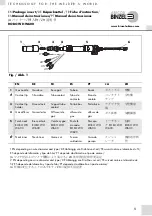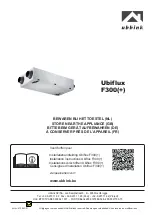
Speidel’s Master Brewer
Page 5 of 26
Pressing
↓
+
↑
simultaneously returns to the initial display of the
Master Brewer.
Cancel / back:
In all operating modes (automatic, programming mode and
manual operation), pressing the buttons
↓
+
↑
returns the user to
the initial position.
3.3
Advice about the recirculating pump
The recirculating pump can be switched on and off via the switch that is located on the
electrical box. It is important that the pump is ventilated after filling up with brewing
water, so that it has the full output. This is done by switching the pump on and off
several times when filled up with water and a mounting position of the pump of 45°
(until no bubbles of air escape any longer and hardly any noise can be heard from the
pump).
3.4
Advice about the container’s lid
The lid assists the temperature being reached more quickly during heating. The
ventilating slots avoid pressure building up in the boiler and they allow the air to
circulate slightly. Water condenses on the lid’s underside at higher temperatures. Care
must be taken when lifting the lid, that the lid’s rim is held over the boiler’s opening,
so that the condensation which runs off (when holding the lid obliquely), runs back
into the boiler and does not run down outside it.
3.5
Advice about hygiene
Hygiene is of paramount importance when brewing beer. The beer or the wort is
exposed to the danger of infection in the cold area especially (when cooling, bottling
[decanting] and fermenting), which can spoil the beer and ruin the whole work.
Therefore pay special attention to absolutely clean containers, (fermenting cask and
bottles) and working materials (spoons, stop cocks and seals). Sulphurous acid is
particularly suitable for disinfecting these containers and objects: it is obtainable from
specialized vintners and hobby-brewing shops. This powder is mixed with water and
thinned: it is suitable for pouring into the fermenting bung, for disinfecting the
fermenting container, other utensils and even the hands. It is typically recommended to
use a bucket of sulphurous acid, in which the hands and utensils are disinfected during
the brewing and before the bottling. The fermenting cask containing 3 to 5 litres of
sulphurous acid is sealed and allowed to stand for several hours. Shake the cask
several times in the meantime, then empty it and allow droplets to drain out before
use. It is unnecessary to rinse it out with water. A few droplets or residue from the
sulphurous acid in the beer are not a cause for concern as a result. Storage casks and
maturing casks are disinfected just like the fermenting containers. The bottles are
disinfected by heating them up in an oven, if the beer is decanted into bottles with
stirrup stoppers for maturation and storage after the fermentation. The rubber seals are
removed from the stirrup stoppers and then boiled in hot water or immersed in
sulphurous acid. The bottles are heated up in the oven to a temperature of approx.
130°C. The bottles are allowed to cool down to room temperature after that by means
of switching off the oven and they are then sealed with the disinfected seals. It is thus
guaranteed that the fermented beer will be decanted into absolutely sterile containers.
This work should be done several days before the fermenting, so that the decanting
process can take place quickly and not at a frantic pace.








































